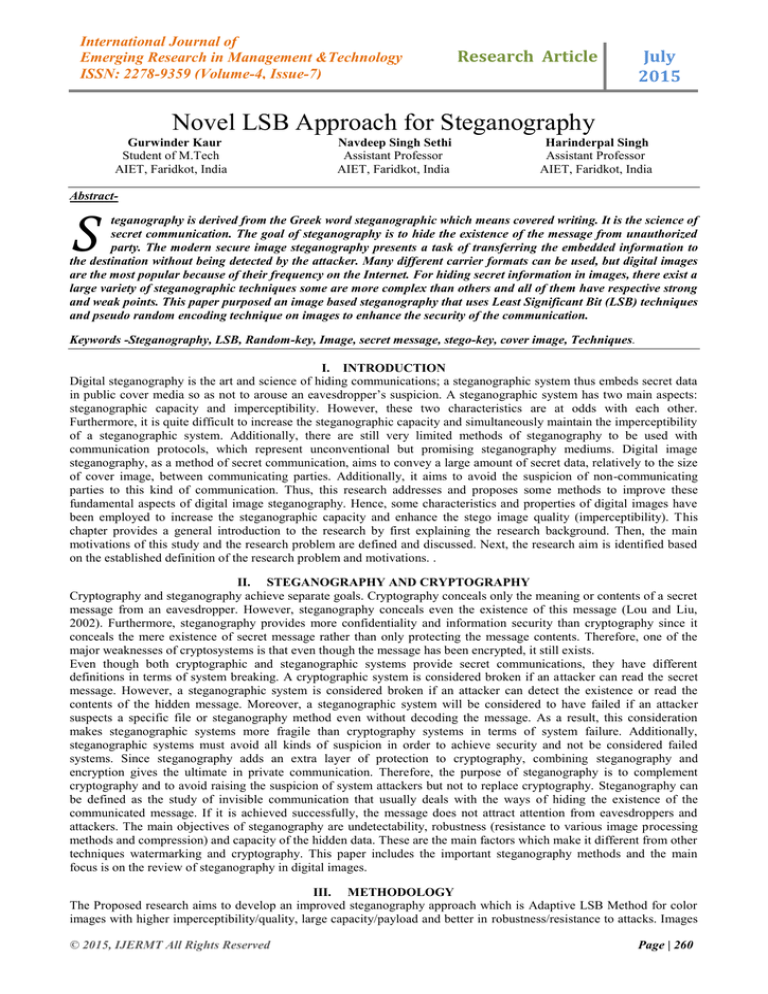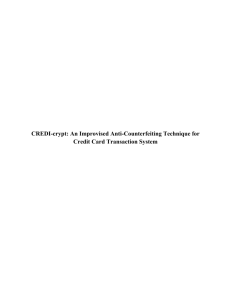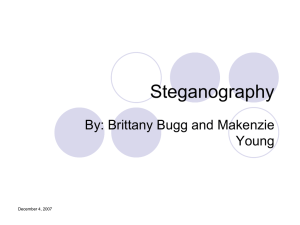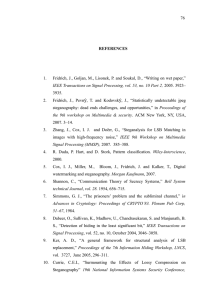
International Journal of
Emerging Research in Management &Technology
ISSN: 2278-9359 (Volume-4, Issue-7)
Research Article
July
2015
Novel LSB Approach for Steganography
Gurwinder Kaur
Student of M.Tech
AIET, Faridkot, India
Navdeep Singh Sethi
Assistant Professor
AIET, Faridkot, India
Harinderpal Singh
Assistant Professor
AIET, Faridkot, India
Abstract-
S
teganography is derived from the Greek word steganographic which means covered writing. It is the science of
secret communication. The goal of steganography is to hide the existence of the message from unauthorized
party. The modern secure image steganography presents a task of transferring the embedded information to
the destination without being detected by the attacker. Many different carrier formats can be used, but digital images
are the most popular because of their frequency on the Internet. For hiding secret information in images, there exist a
large variety of steganographic techniques some are more complex than others and all of them have respective strong
and weak points. This paper purposed an image based steganography that uses Least Significant Bit (LSB) techniques
and pseudo random encoding technique on images to enhance the security of the communication.
Keywords -Steganography, LSB, Random-key, Image, secret message, stego-key, cover image, Techniques.
I. INTRODUCTION
Digital steganography is the art and science of hiding communications; a steganographic system thus embeds secret data
in public cover media so as not to arouse an eavesdropper’s suspicion. A steganographic system has two main aspects:
steganographic capacity and imperceptibility. However, these two characteristics are at odds with each other.
Furthermore, it is quite difficult to increase the steganographic capacity and simultaneously maintain the imperceptibility
of a steganographic system. Additionally, there are still very limited methods of steganography to be used with
communication protocols, which represent unconventional but promising steganography mediums. Digital image
steganography, as a method of secret communication, aims to convey a large amount of secret data, relatively to the size
of cover image, between communicating parties. Additionally, it aims to avoid the suspicion of non-communicating
parties to this kind of communication. Thus, this research addresses and proposes some methods to improve these
fundamental aspects of digital image steganography. Hence, some characteristics and properties of digital images have
been employed to increase the steganographic capacity and enhance the stego image quality (imperceptibility). This
chapter provides a general introduction to the research by first explaining the research background. Then, the main
motivations of this study and the research problem are defined and discussed. Next, the research aim is identified based
on the established definition of the research problem and motivations. .
II. STEGANOGRAPHY AND CRYPTOGRAPHY
Cryptography and steganography achieve separate goals. Cryptography conceals only the meaning or contents of a secret
message from an eavesdropper. However, steganography conceals even the existence of this message (Lou and Liu,
2002). Furthermore, steganography provides more confidentiality and information security than cryptography since it
conceals the mere existence of secret message rather than only protecting the message contents. Therefore, one of the
major weaknesses of cryptosystems is that even though the message has been encrypted, it still exists.
Even though both cryptographic and steganographic systems provide secret communications, they have different
definitions in terms of system breaking. A cryptographic system is considered broken if an attacker can read the secret
message. However, a steganographic system is considered broken if an attacker can detect the existence or read the
contents of the hidden message. Moreover, a steganographic system will be considered to have failed if an attacker
suspects a specific file or steganography method even without decoding the message. As a result, this consideration
makes steganographic systems more fragile than cryptography systems in terms of system failure. Additionally,
steganographic systems must avoid all kinds of suspicion in order to achieve security and not be considered failed
systems. Since steganography adds an extra layer of protection to cryptography, combining steganography and
encryption gives the ultimate in private communication. Therefore, the purpose of steganography is to complement
cryptography and to avoid raising the suspicion of system attackers but not to replace cryptography. Steganography can
be defined as the study of invisible communication that usually deals with the ways of hiding the existence of the
communicated message. If it is achieved successfully, the message does not attract attention from eavesdroppers and
attackers. The main objectives of steganography are undetectability, robustness (resistance to various image processing
methods and compression) and capacity of the hidden data. These are the main factors which make it different from other
techniques watermarking and cryptography. This paper includes the important steganography methods and the main
focus is on the review of steganography in digital images.
III. METHODOLOGY
The Proposed research aims to develop an improved steganography approach which is Adaptive LSB Method for color
images with higher imperceptibility/quality, large capacity/payload and better in robustness/resistance to attacks. Images
© 2015, IJERMT All Rights Reserved
Page | 260
Kaur et al., International Journal of Emerging Research in Management &Technology
ISSN: 2278-9359 (Volume-4, Issue-7)
as well as text messages can be hidden within the images using sequential and random methods. It will incorporate
cryptography to achieve high security and random pixel embedding to attain high immunity to attacks. It would be highly
immune to any environmental disturbances like noise due to hybrid filtering.
The proposed system comprises of two components:
1. Embedding Module
2. Extracting Module.
A. Embedding Module
Embedding is the process of hiding the embedded message generating the stego image. Hiding information may require a
Stego key which is additional secret information, such as password, required for embedding the information.
For example, when a secret message is hidden within a cover image, the resulting product is stego image (stego object).
The main algorithm for the embedded stage can be listed as follow:
1. Input the secret text/image files that to be hidden in the cover image.
2. Select the cover image (JPEG file) from list of stored Image files and the text files.
3. Calculate the size of the secret text.
4. Substitute the secret characters/Image from step 4 to cover image obtained from step 2 randomly as follows
a) Calculate the RGB values for every pixel of the cover image to embed the hidden text
b) Find the minimum value from these three values of Red, Green and Blue.
c) Choose this color to be target color to embed the secret message in it.
d) Embed the message and Repeat step 4 for complete secret message.
B. Extracting Module
Extracting is the process of getting the embedded message from the stego image.
The main algorithm for the embedded stage is as follow:
1. Extraction of secret text message from stego image is carried out from random pixels of cover image
2. For edge areas: Extract data from which has the highest value among the three color Red, Green and Blue.
3. For smooth areas: Extract data from adaptive no. of bits.
IV. RESULTS AND DISCUSSION
We have conducted several experiments to examine the effectiveness of proposed algorithm. We choose the cover image
of buildings, people and vehicles and images to hide as logo images and various text. All the images are of different sizes
and taken from real world data. Proposed system is tested on more than 50 images with different watermarks for data
hiding. System is giving 94% accurate results. The following table shows the statistics of the proposed system.
Parameter
Value
Total Images Tested
50
Text Watermark
25
Image Watermark
25
System Accuracy
94%
Fig:-results of novel LSB approach
PSNR (Peak Signal to Noise Ratio) of the obtained stego-image can be computed by PSNR worst =20 × log10
(255/MSE) dB (3.1)
The results are then compared with various steganography methods as shown in the following table. In current work
more pixel values is change because the simple LSB replacement depends upon size of image. Comparative study of
previous method and Adaptive LSB substitution method is shown below:
Table 2. Comparison of Novel LSB Approach with other techniques
Input Image
LSB3
Jae Giyu
Novel LSB
PSNR
37.92
38.98
49.32
Accuracy
86.52
88.62
94.02
V. CONCLUSION
There are several types of algorithms for steganography. Each type of algorithms has its own advantages and limitations.
No method can provide fully perfect solution. Each type of solution has robustness to some type of attacks but is less
resilient to some other types of attacks. Main focus of the current research in this field is to make the steganography
algorithms resilient to geometric transformations. In case of practical application, choice of solution type actually
depends on the nature of application and requirements. The proposed method uses Novel LSB Method to optimize the
strength of steganographic process. The imperceptibility and robustness of proposed method shows better performance in
comparison to other approaches in practice. Accuracy of the system evaluated to be 94% which shows considerably good
improvement over the existing approaches.
© 2015, IJERMT All Rights Reserved
Page | 261
Kaur et al., International Journal of Emerging Research in Management &Technology
ISSN: 2278-9359 (Volume-4, Issue-7)
VI. FUTURE SCOPE
Proposed system can embed the steganograph such as images as well as text in the image of any format. We proposed
two algorithms, one for embedding the stego image into a cover image and second for decoding the message from the
encoded image. Proposed system shows good results But it has one major limitation which is system cannot embed the
image message larger than the image in which message to e hide. Further the proposed system can also be extended to
embed watermark in the video file.
REFERENCES
[1]
Vijay Kumar Sharma, Vishal Shrivastavaa “Steganography Algorithm For Hiding Image In Image By Improved
LSB Substitution By Minimize Detection”
[2]
Gurpreet Kaur, Kamaljeet Kaur, Image Watermarking Using LSB (Least Significant Bit)
[3]
Amit Singh, Susheel Jain, Anurag Jain, Digital watermarking method using replacement of second Least
significant Bit(LSB) with inverse of LSB
[4]
Nayan K. Dey ,Suman K. Mitra ,Ashish N. Jadhav , Hybrid Scheme for Robust Digital Image Watermarking
Using Dirty Paper Trellis Codes
[5]
Lahouari Ghouti, Ahmed Bouridane, Mohammad K. Ibrahim, and Said Boussakta, Digital Image Watermarking
Using Balanced Multiwavelets
[6]
Amir Houmansadr, Shahrokh Ghaemmaghami, A Digital Image Watermarking Scheme Based on Visual
Cryptography
[7]
Neil F. Johnson2, Zoran Duric1, and Sushil Jajodia2 “Recovery of Watermarks from Distorted Images”
[8]
Henri Bruno Razafindradina and Attoumani Mohamed Karim, BLIND AND ROBUST IMAGES
WATERMARKING BASED ON WAVELET AND EDGE INSERTION
[9]
Prabhishek Singh, R S Chadha, A Survey of Digital Watermarking Techniques, Applications and Attacks
[10]
Vinita Gupta, Mr. Atul Barve, A Review on Image Watermarking and Its Techniques
[11]
Chan-Il Woo and Seung-Dae Lee, Digital Watermarking for Image Tamper Detection using Block-Wise
Technique
[12]
Gopika V Mane, G. G. Chiddarwar, Review Paper on Video Watermarking Techniques
[13]
Rajat Tiwari, Navneet Kaur, Manpreet Kaur, An Optimization Image Watermarking Technique Using
Biogeography Based Optimization
[14]
Yonghong Chen, Jiancong Chen, Digital Image Watermarking Based on Mixed Error Correcting Code
[15]
Saeed AL-Mansoori and Alavi Kunhu, Robust Watermarking Technique based on DCT to Protect the
Ownership of DubaiSat-1 Images against Attacks
© 2015, IJERMT All Rights Reserved
Page | 262




